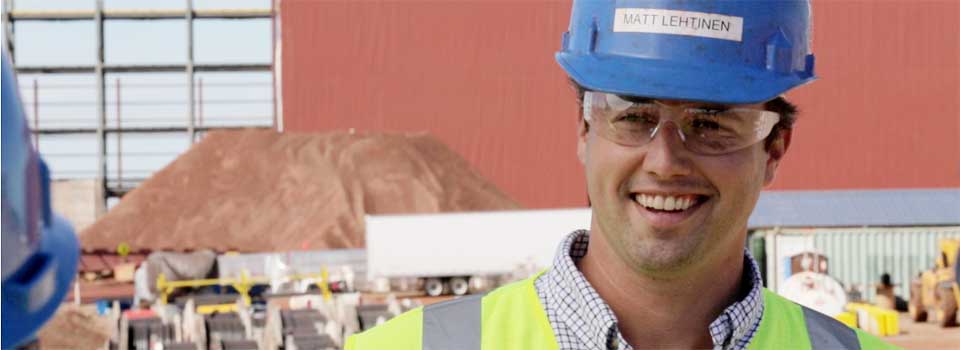Mining smarter, cleaner
Mining smarter, cleaner
| Author: | William Meiners |
|---|---|
| Magazine Section: | Always |
| College or School: | CoE |
| Article Type: | Issue Feature |
| Feature Intro: | Imagine extracting iron ore from Minnesota mines dating back to the 1890s. All without disturbing any new land. With a Purdue alumnus at the helm of Magnetation, that’s become a reality. |
Matt Lehtinen (ECE ’04), the president and chief operating officer, is charged with the day-to-day logistics of keeping Magnetation humming. Given a global climate that calls for worldwide industrialization that’s less harmful to the environment, Lehtinen believes that the Minnesota-based company is well-positioned for competition with longstanding multinational companies.
“What makes Magnetation unique from an eco perspective is that we’re recycling former waste areas without disturbing any new land,” Lehtinen says. “We’ve come up with a mineral beneficiation process that can efficiently refine those waste stockpiles into a high-value iron ore concentrate, which is the primary raw ingredient for the production of steel. And we have zero water discharges or air emissions at our mine sites.” For a glimpse into that process, watch the “Magnetation: What We Do” video.
Along with the environmental obligation is what Lehtinen describes as an entrepreneurial spirit in the company, which has three plants in Minnesota and now an iron ore pellet-producing plant in Reynolds, Indiana. Those pellets are sent to the Ohio and Kentucky blast furnaces of partner AK Steel, with which Lehtinen helped negotiate a joint venture. Next, they’re looking to take the innovative refinement process to mining districts in Canada, South America and Australia.
White County — all in
Each month Lehtinen travels from the Minnesota headquarters back to a town just north of his alma mater, where the plant in Reynolds went live in September. He’s helped set up operations on the $350 million pellet plant — the largest private investment in White County. From 1,000 construction workers on site who helped build the plant to the 120 new employees with an average take-home wage between $60,000 and $70,000, Magnetation has provided a boom to the local economy.
The skills of tradesmen, technicians and engineers keep the plant running. And their responsibilities include everything from operating large pieces of equipment to material handling. Laboratory technicians, process engineers, mechanics and electricians all apply their trades on a daily basis.
Lehtinen describes this first plant outside of Minnesota as an all-around win. “It starts with our company having a lot of respect for the community and making sure we have a positive impact by doing things the right way,” he says. “Then the culture and attitude of the town, a farming area known for its hard work ethic and hospitality, has led to a very harmonious situation. A lot of people in a lot of communities would be very upset about a manufacturing plant, even a clean manufacturing plant like ours, popping up in its backyard. But Reynolds has welcomed us with open arms.”
In addition to his various roles in finance, human resources and community relations, Lehtinen is very much involved in the operation of the plant. He can access the process automation system in real time at any of the four plants from his iPad. “We utilize the latest information technology and industrial automation technology to control our manufacturing plants and our mines,” he says.
‘Mag time’
That mind for automation, as well as what he considered the possibilities of computing, may have led Lehtinen to the School of Electrical and Computer Engineering. He grew up in several Big Ten states, including Minnesota, Michigan and Ohio, but as he finished high school in Auburn, Indiana, Purdue offered a great engineering option and in-state tuition.
Still, even coming out of one of the most challenging programs at Purdue where he kept himself busy on the Purdue Student Engineering Council and in leadership roles within his fraternity, Lehtinen had to learn the ropes of iron ore mining on the job. He held previous engineering positions at Mesabi Nugget Pilot Plant and Rockwell Automation, but the technology involved with processing iron ore tailings from old mines presented a new learning curve.
Lehtinen fell back on the problem-solving skills he learned at Purdue. “My engineering education prepared me to become an expert in a different technical field as we began building the company,” he says. “It certainly prepared my character and work ethic to have success in the business world.”
Part of that post-Purdue education on mineral processing within a startup company began to pay dividends five years ago when Magnetation engineers patented the Rev3 Separator, which led to higher-volume extractions. Lehtinen subsequently negotiated a seven-year contract agreement with Altos Hornos de Mexico, or AHMSA, as well as the $300 million joint venture with AK Steel, and has provided oversight on successful construction and expansion projects.
In a company culture marked by efficiency, safety and everything clean and green, Magnetation employees often use lingo to liken things to “mag time” and at “mag speed.” For Lehtinen, a Boilermaker just a decade removed from his own graduation, this business of making old mines new again has made for a decidedly fast track.

Comments